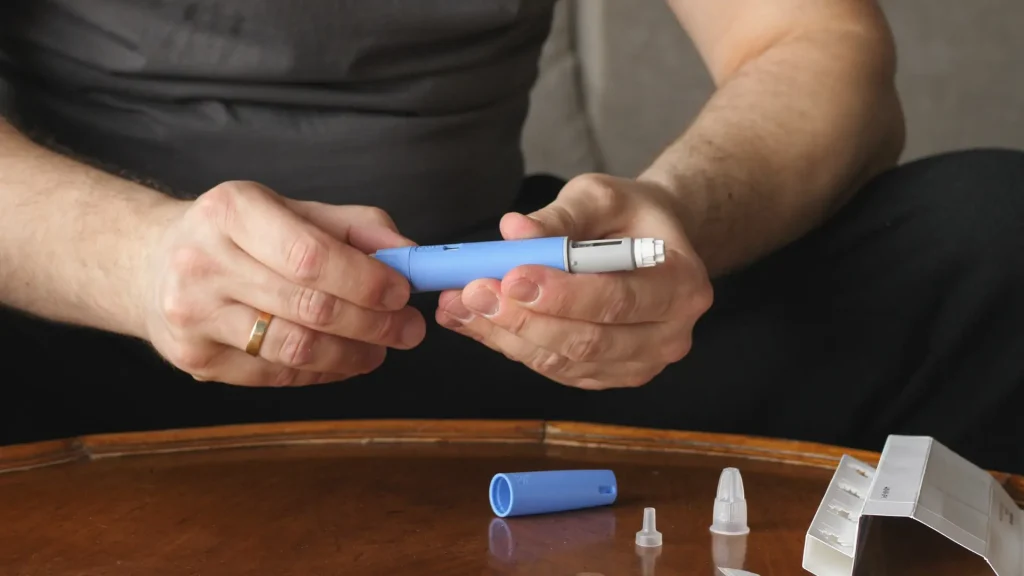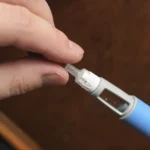
According to the World Health Organization, the global scale of weight management concerns is staggering, with 2.5 billion adults aged 18 and older classified as overweight. Alarmingly, 890 million individuals were grappling with obesity as of 2022. These figures serve as a reminder of the critical importance of addressing weight management issues globally.
Obesity and overweight are prevalent among adolescents and adults worldwide. The escalating number of these weight-related cases has likely prompted individuals to seek solutions for their predicament. Saxenda, an injectable prescription medicine, has emerged as a recognized solution for long-term weight management, catering to both adults and adolescents alike.
This article will explore stopping and restarting Saxenda treatment for weight loss, the possible reasons for stopping, and the potential effects of restarting their weight loss progress.
Key Takeaways
- Some patients may discontinue their Saxenda injections for various reasons, such as Saxenda side effects, financial considerations, and after achieving weight loss goals.
- Before stopping their Saxenda journey, patients must understand that this can potentially affect their bodies.
- Returning to Saxenda treatments requires medical supervision, as providers must evaluate the patient’s health, weight concerns, and potential risks before resuming.
- The effectiveness of Saxenda after restarting may vary from person to person, with some finding the medication less effective, while others may experience similar effects as before.
- Seeking these providers’ interventions can lead to more effective treatment and minimized complication risks.
About: Medica Depot is your trusted all-in-one supplier, offering a range of high-quality medical injectables and supplies. If you’re looking to order Saxenda online, our dedicated sales agents can give you proper guidance. We offer a worry-free experience in searching for the best and most popular products on the market. Whether for health professionals, plastic surgeons, dermatologists, licensed estheticians, or other specialists, we can offer genuine, brand-name products you may need. With Medica Depot, we prioritize serving you better to improve the patient’s quality of life.
Reasons for Stopping Saxenda Treatment
Saxenda has proven its safety and efficacy in addressing weight-related concerns, such as obesity in adults and adolescents. It’s worth noting that this injection therapy requires a long-term treatment process. However, some patients may discontinue their Saxenda injections due to various reasons.
- Patient Discomfort or Saxenda Side Effects: Patients may experience several temporary side effects after treatments. This includes nausea, vomiting, or diarrhea, and these discomforts can lead to discontinuation of the Saxenda treatment.
- Financial Constraints: Given its long-term treatment, Saxenda may be expensive without insurance. The maintenance of this prescription medicine may urge some patients to stop treatment due to financial considerations.
- Achieving Weight Loss Goals: Once patients achieve their weight loss goals, they may halt their Saxenda injection treatments under medical supervision. However, it’s essential to consult a healthcare provider before making any medication changes.
Another reason individuals stop the injection is to find Saxenda alternatives. Some patients may try other injectable brands for their weight loss management. However, patients should know that communicating with medical professionals can give them a safe process for stopping Saxenda treatments and moving to other brands.
Potential Effects of Stopping Saxenda on Weight Loss Progress

Before stopping their Saxenda journey, patients must understand that this can potentially affect their bodies. Open communication with medical professionals can ensure the safe management of these effects and can help patients manage their expectations regarding their concerns.
- Rebound Weight Gain: Stopping Saxenda injections may result in rebound weight gain. Without the injectable’s appetite-suppressing effects, patients may consume more calories, which can lead to weight regain.
- Metabolic Changes: Saxenda injections affect the patient’s metabolic rate. Discontinuing the medication may slow the metabolism, making it harder to maintain or lose weight. A healthy and balanced diet and exercise may not significantly help lose weight.
- Psychological Impact: When stopping the medication, patients may feel anxious or disappointed if their weight loss slows or reverses. Individuals need to manage these feelings and seek professional help if necessary.
Clinical Guidelines and Expert Recommendations on Restarting Saxenda
While stopping Saxenda is possible, medical professionals can also guide individuals who wish to restart the medication. Returning to Saxenda treatments requires medical supervision, as providers must evaluate the patient’s health, weight concerns, and potential risks before resuming.
Medical professionals should discuss the contraindications of Saxenda and ensure that patients are suitable to undergo the long-term treatment. They should not use Saxenda if:
- Patients or their families have ever had medullary thyroid carcinoma (MTC) or multiple endocrine neoplasia syndrome type 2 (MEN 2).
- Patients have a severe allergic reaction to liraglutide or any of the ingredients in Saxenda.
- Pregnant or have plans to become pregnant.
These providers must also know about the patient’s medical history and lifestyle to determine if Saxenda can effectively address their concerns. The effectiveness of Saxenda after restarting may vary from person to person. Some patients may find the medication less effective, while others may experience similar effects as before.
Furthermore, providers know the importance of patient education and counseling in allowing individuals to make informed decisions for their treatment. This includes providing them with comprehensive information about the potential Saxenda side effects, the disadvantages of Saxenda and alcohol, and the benefits of restarting the medication. Counseling can help manage expectations and ensure adherence to the treatment plan.
Potential Side Effects of Restarting Saxenda

Like any other medical or aesthetic treatment, patients can expect potential side effects when restarting Saxenda injections. They may have experienced these symptoms during their first time trying Saxenda, and medical professionals know how to manage these side effects properly.
- Gastrointestinal Issues
- Changes in Appetite
- Injection Site Reactions
Moreover, Saxenda also listed the most common side effects that patients may experience after their injections. These include nausea, diarrhea, constipation, vomiting, injection site reaction, low blood sugar (hypoglycemia), headache, upset stomach (dyspepsia), tiredness (fatigue), dizziness, stomach pain, and changes in enzyme (lipase) levels in the blood.
These side effects are usually temporary and may lessen over time. However, if these persist or worsen, patients must seek medical attention. Always consult a healthcare professional for any concerns.
Strategies to Safely Restart Saxenda Treatment
Medical professionals know the best practices for helping patients restart their Saxenda treatments safely. Seeking these providers’ interventions can lead to more effective treatment and minimized complication risks.
- Gradual Dose Titration: Providers may require this method for individuals restarting Saxenda. Gradual dose titration involves starting with a low dose and slowly increasing it to help minimize potential side effects.
- Monitoring for Adverse Effects: Regular monitoring for adverse effects is vital for those restarting Saxenda. Patients should report unusual symptoms to their healthcare providers for proper assessment and management.
- Lifestyle Modifications and Support: Combining Saxenda with lifestyle modifications, such as a balanced diet and regular exercise, can significantly help manage weight loss. Moreover, providers’ support and support groups also benefit those resuming their treatment.
Managing Patients Who Need to Stop and Restart Saxenda Treatment


Various factors may occur during patients’ Saxenda journey, which can halt their treatment or urge them to restart. Understanding how the treatment works, its advantages, and what risks it can cause can help them decide whether to stop or restart. Counseling can help manage these expectations and ensure strict adherence to the treatment plan.
A collaborative approach involving other healthcare professionals, dietitians, and psychologists can deliver a tailored and comprehensive care and treatment plan for patients restarting Saxenda. This can also help individuals who wish for long-term weight management, as it involves regular follow-ups and weight management programs.
These long-term supports can help patients maintain their weight loss goals after restarting Saxenda. Consistency with this holistic approach can enhance the injectable treatment’s effectiveness.
Conclusion
Stopping and restarting Saxenda treatment is a complex process that requires careful consideration. There are various reasons why a patient might stop Saxenda treatment, including financial constraints or achieving weight loss goals. However, stopping the treatment can significantly affect weight loss, such as rebound weight gain or metabolic changes.
When restarting Saxenda, it is crucial to follow clinical guidelines and expert recommendations. Patients should be aware of potential side effects and strategies for safely restarting the treatment. The decision to stop or restart Saxenda is always made in consultation with a healthcare professional.
FAQs
- What are some reasons for stopping Saxenda treatment?
Patients may discontinue Saxenda treatment due to temporary side effects, financial constraints, or after achieving their weight loss goals.
- What are the potential effects of stopping Saxenda on weight loss progress?
Stopping Saxenda injections may lead to rebound weight gain, metabolic changes, and psychological impact on weight loss progress.
- What are the clinical guidelines and expert recommendations on restarting Saxenda?
Restarting Saxenda requires medical supervision and evaluation. Patients should not restart Saxenda if they have specific medical conditions or severe allergic reactions. Medical professionals must understand the patient’s medical history and lifestyle before considering the restart.
References
- World Health Organization. (2024, March 1). Obesity and overweight. World Health Organization. https://www.who.int/news-room/fact-sheets/detail/obesity-and-overweight
- Saxenda® liraglutide injection 3mg. (n.d.). Www.novo-pi.com. Retrieved June 7, 2024, from https://www.novo-pi.com/saxenda.pdf
Clinical aesthetics products refer to a category of products used in the field of medical aesthetics or cosmetic dermatology. These products are typically designed and formulated to be used under the supervision of healthcare professionals, such as dermatologists, plastic surgeons, or trained aestheticians. They are distinct from over-the-counter cosmetics in that they often contain active ingredients or formulations that require expertise in their application or administration.
Examples of clinical aesthetics products include:
-
Dermal Fillers: Injectable substances used to add volume, smooth wrinkles, and enhance facial contours. Examples include hyaluronic acid fillers like Juvederm and Restylane.
-
Botulinum Toxin (Botox): Injectables that temporarily paralyze facial muscles to reduce the appearance of wrinkles caused by repetitive movements, such as frown lines and crow's feet.
-
Chemical Peels: Solutions applied to the skin to exfoliate and improve its texture. They can treat acne, pigmentation issues, and signs of aging.
-
Laser and Light Therapies: Devices that emit focused light or laser energy to treat various skin conditions, including acne, scars, and signs of aging.
-
Prescription Skincare Products: Formulations containing active ingredients like retinoids (vitamin A derivatives), hydroquinone, or prescription-strength antioxidants to address specific skin concerns under medical supervision.






